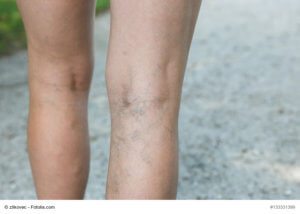Spider veins vs varicose veins: what's the difference and why does it matter? Well, both are vascular concerns. And both can impact the appearance of your legs. But there are clear differences between the two. And understanding those differences will help you find the right treatment. Let's take a closer look!
Spider veins, also called telangiectasia, form when valves in your veins malfunction. This allows blood to pool, making your veins visible through your skin. Spider veins are usually smaller and closer to the surface of your skin. Their most notable feature is their red, purple or blue color, and their resemblance to spider webs. (See how they got their name?) These troubled veins most commonly appear on your legs, chest and face.
Like spider veins, varicose veins form due to malfunctioning valves that allow blood to pool in your veins. But varicose veins are much larger. Also, they usually have a twisted, ropelike appearance. And they are visibly raised above the surface of your skin.

Vein disease is progressive. So a vascular problem that starts as spider veins could progress and become varicose veins. In other words, varicose veins are a more serious medical concern than spider veins. As such, they may need a more aggressive intervention.
In contrast, we can usually treat spider veins with minimally invasive options, since the troubled veins sit close to the surface of your skin. If you're dealing with a later disease stage, though, you may be looking at a more involved treatment and recovery plan.
With surface-level vein health concerns, we can usually resolve your concerns with cosmetic sclerotherapy. This treatment involves. To deliver relief, we use a tiny needle to inject a solution directly into your affected veins. Soon, this solution causes your vein lining to seal itself. This prevents further blood flow and, soon, the spider veins should dissapear.
Now, if you have varicose veins, radiofrequency ablation (RFA) may be a better treatment option. If you choose RFA, we'll insert a catheter into one of your abnormal veins, supplying it with a heat energy that permanently closes the vein. While more involved than sclerotherapy, you only need a local anesthetic to receive RFA, and you'll be left with almost no scarring. In the hour or less it takes to receive RFA, you'll experience little pain. Afterward, you can almost always resume normal activities immediately, and you should experience near-immediate improvement in your condition.
Most patients can avoid downtime when they choose sclerotherapy or RFA. After any vein treatment, you'll need to wear compression socks. And we recommend protecting the treated area from exposure to the sun. But how can you know which form of vein treatment is best for you?
The only way to determine your proper treatment plan is to schedule a consultation at one of our Houston and Dallas area vein clinics. During your visit, we can perform a diagnostic ultrasound to determine the extent of your vascular concerns. At that time, we can discuss your best treatment options, and perfect a plan that will bring you lasting relief!

Scheduling
Please contact our dedicated specialists to schedule a consultation today.
2025 Texas Endovascular. All rights reserved. Website Design by Healthcare Success